-
Photonics has attracted great research interest over the last decade for its prospects in the creation of functional devices both for near-infrared (NIR) and mid-infrared (MIR) wavelengths1. Optical modulators are key elements of photonic circuits that enable signal switching and routing, data encoding, phase-sensitive detection, and spectroscopic interrogation2. For NIR modulators, combining with optical platforms like fibers, grating and resonators, various types of materials, especially two-dimensional (2D) materials, have spurred a variety of researches recently3-5. Tan et al. reviewed the properties of 2D materials and introduced the design, fabrication and application of these 2D material-based optical devices3. Zheng et al. reported a four-layer phosphorene-decorated microfiber for all-optical modulation at telecom band. They also demonstrated that the mode-locked fiber laser can be used as control light to modulate on/off continuous wave signal light with modulation depth of 4.74. Wang et al. reported an all-optical phase modulator using phosphorene-deposited microfiber. A maximal phase shift of 8π rad is obtained with control light of 290 mW at 1550 nm. Such a phase modulator is further demonstrated as an information loader with modulation depth of 17 dB and response time of 2.5 ms5.
The motivation for investigating modulator wavelengths further into MIR comes from the applications that are possible for photonics and sensing in this range. MIR modulators has a wealth of applications, including actively Q-switched laser generation, environmental pollution monitoring, chemical and bio-sensing, industrial processes control, multispectral thermal imaging, and medical diagnostics of early disease, etc1,2,6. To date, most of the MIR modulators are established on waveguide-integrated or free-space platforms7-8. On-chip integrated devices have attracted great attention due to it s flexible waveguide geometry and complementary metal oxide semiconductor compatibility. Various waveguide- integrated modulators have been demonstrated, including those based on electro- optic9, thermo-optic10, free carrier plasma dispersion11, and electro-absorption effects12. Most waveguide-integrated modulators are based on the silicon-on-insulator13 or silicon-on-lithium-niobate14 platform, which are mainly used in the NIR region due to stronger material absorption at longer wavelengths15. For free-space modulators, metamaterial16, hybrid17 and pattern structures18 are commonly used to enhance light-matter interaction to achieve higher modulation efficiency. Most of the MIR modulators are electrically driven with external electronics applied directly on the modulation devices6.
Here we report a novel method to achieve MIR phase modulation by exploiting photo-thermal (PT) effect in an acetylene (C2H2)-filled anti-resonant hollow-core fiber (AR-HCF). PT effect in gas-filled HCFs has been exploited for ultra-sensitive gas detection19-21. Gas absorption of a pump beam generates heat, which modulates the phase of an NIR probe beam propagating through the fiber. Interferometric detection of the phase modulation allows the retrieval of gas concentration. The long interaction distance and near perfect overlap of the pump and probe fields with gas material in the HCF significantly enhance light-gas interaction, which enables larger phase modulation and hence better gas sensitivity over free-space systems22,23. In the present work, we extend the application scope of PT effect in the gas-filled HCFs to MIR phase modulators. Different from the voltage-driven waveguide and free-space modulators, the PT MIR phase modulators are driven optically by a cost-effective control laser in NIR telecom band. By placing the phase modulator (PM) in one arm of a Mach-Zehnder interferometer (MZI), MIR intensity modulation (IM) is further demonstrated. The AR-HCFs intrinsically have broadband transmission, which coupled with the narrow absorption lines of gas materials, makes it possible to develop ultra-broad band all-optical modulation devices from NIR to MIR.
-
The basics of the phase modulator are shown in Fig. 1. It uses an AR-HCF with cross-section shown in the inset of the figure24. The AR-HCF consists of a single ring of six non-touching silica capillaries with diameter of ~36 μm and thickness of ~0.76 μm, giving an inscribed inner hollow-core diameter of ~70 μm. The outer diameter of the fiber is 250 μm. The AR-HCF has a low transmission loss of less than 0.5 dB/m from 1.55 μm to 3.35 μm, which is measured using a cut-back method25. The transmission window of the state-of-the-art AR-HCFs can be further extended to longer MIR wavelengths26.
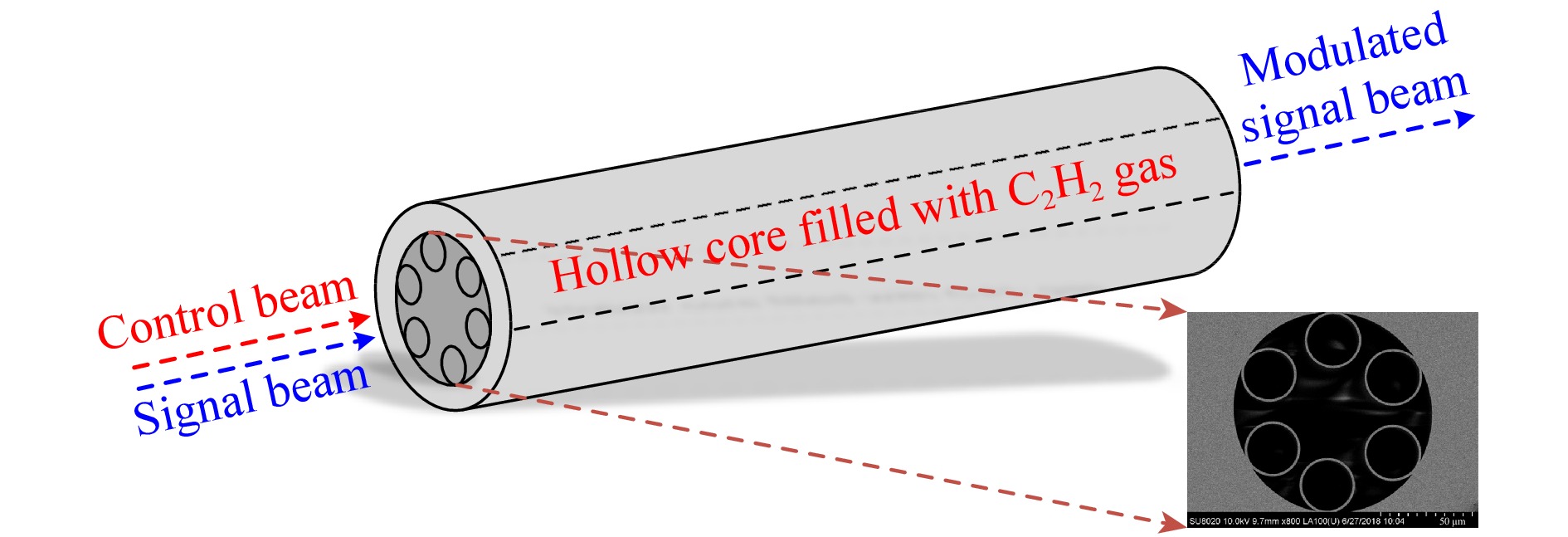
Fig. 1 Basics of the all-optical phase modulator with an acetylene-filled AR-HCF. The inset is the cross-sectional image of the AR-HCF.
The AR-HCF is filled with pure C2H2 at different gas pressure. Optical absorption of the control beam promotes the gas molecules to a higher energy level, which induces localized heating through non-radiative relaxation and modulates the refractive index (RI) of the gas material and hence the accumulated phase of the signal beam propagating through the AR-HCF. By placing the phase modulator in one arm of an MZI, an optically controlled intensity modulator can also be realized.
The experimental set-up is depicted in Fig. 2. It may be regarded as comprising of three modules: the optical driver, the PM, and the MZI. The MZI is used to characterize the PM, as well as to form, in combination with the PM, an intensity modulator (IM). In the optical driver, a distributed feedback (DFB) laser is used as the control light source and its wavelength is tuned to the P(9) absorption line of C2H2 at 1530.371 nm. The intensity of the control beam is modulated by an acoustic optical modulator (AOM) and amplified by an erbium-doped fiber amplifier (EDFA). A wavelength-division multiplexer (WDM) with narrow transmission bands is used to filter out the amplified spontaneous emission noise from the EDFA. The WDM is also used to couple an NIR signal beam into the system, as will be described in later section. An optical collimator (OC) is used to collimate the control beam, which is coupled into the HCF via a dichroic mirror (DM reflectivity: 99%@1.53 μm, 95%@1.55 μm; transmittance: 80%@3.35 μm) and a convex lens (f = 25 mm).
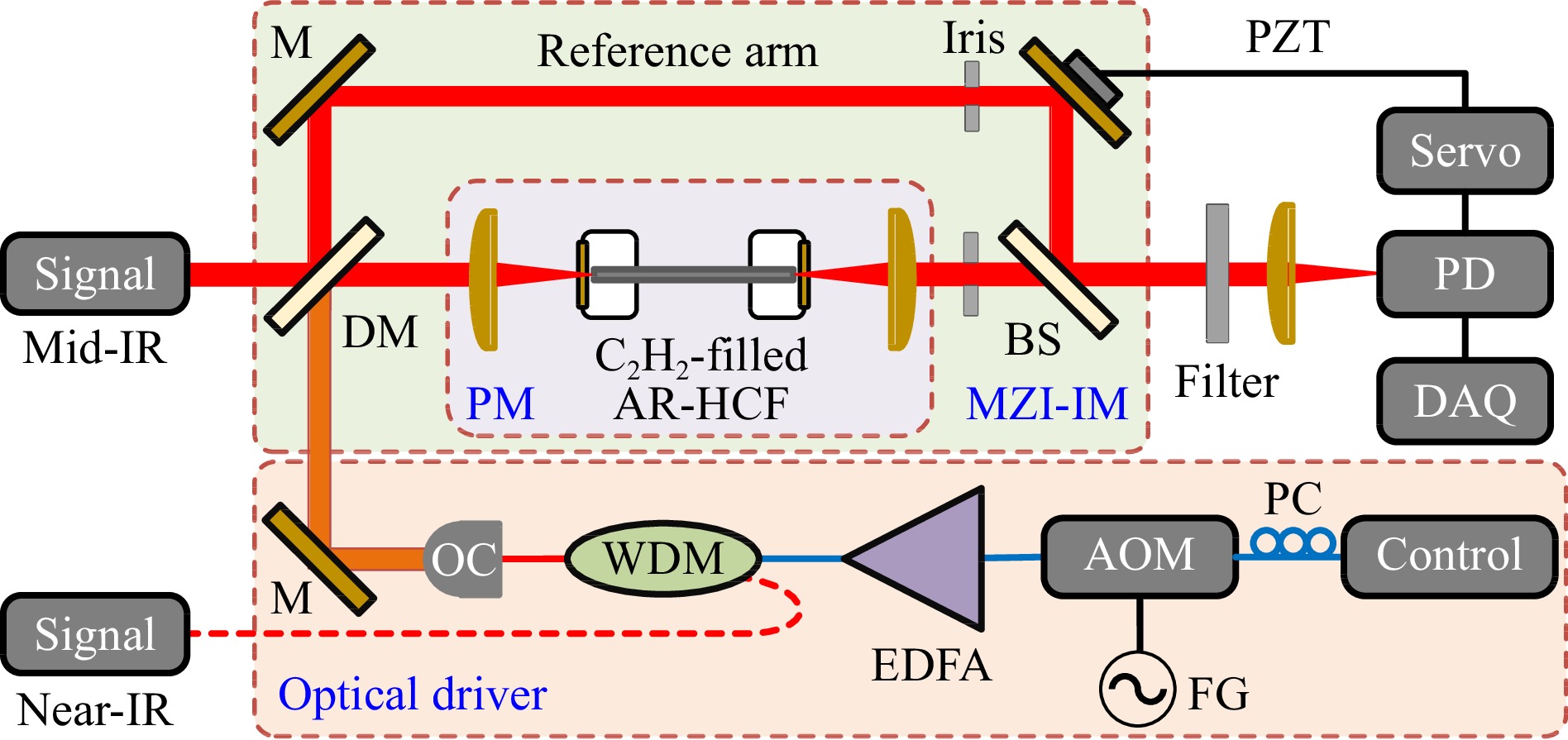
Fig. 2 Experimental set-up for phase and intensity modulation measurement. PM: phase modulator, IM: intensity modulator, PC: polarization controller, FG: function generator, EDFA: erbium-doped fiber amplifier, WDM: wavelength-division multiplexer, OC: optical collimator, DM: dichroic mirror, BS: beam splitter, PZT: piezoelectric transducer, DAQ: data acquisition card, PD: photodetector.
The gas-filled HCF is the core element of the PM. The two ends of the HCF are sealed inside two gas chambers with CaF2 windows for light coupling. A gap of ~1 mm is introduced between the CaF2 windows and the HCF, which enables gas-filling into the HCF at different gas pressure. It should point out that, for practical applications, the HCF will be sealed with high tightness once the gas type, pressure and concentration are confirmed, therefore no external gas chamber, pump, and gas control system is required. A 3.35 μm interband cascade laser (ICL) is used as the MIR signal source to characterize the phase modulator. The insertion loss of the PM is ~3 dB, mainly caused by the signal beam-HCF coupling efficiency, this can be further optimized by using the MIR single-mode fiber-HCF coupling method21. The MIR signal beam is split into two by the DM. One beam passes through the PM while the other acts as a reference beam, which are spatially combined with a spatial beam splitter (BS) with a splitting ratio of 50:50 and further focused into a photodiode. A filter is used to block the residual control beam (around 1530 nm) from the AR-HCF. A servo-loop with a piezo-mounted mirror is used to stabilize the MZI to a particular operating point.
The MZI, with the PM placed in one arm, can also be used as an IM. To balance the optical power in the two arms, two irises are used, one in each arm. The insertion loss of the IM is ~6.9 dB at 3.35 μm and ~13 dB at 1.55 μm. The higher loss at NIR band is attributed to the coupling loss into HCF (~3 dB), the natural loss of the BS (3 dB), and the DM that has low transmittance at 1.55 μm. This loss may be reduced by optimizing the coupling efficiency into the HCF, and using a more suitable DM and iris to match the power distribution of the two MZI arms.
-
The performance of a phase modulator made of a 19-cm-long AR-HCF filled with C2H2 is evaluated using the setup in Fig. 2 with the MZI stabilized at quadrature point. Fig. 3a shows the DC-output from the MIR photodetector without servo-control. As shown in Fig. 3b, the MZI output with servo-locking around the quadrature point is used to estimate the long-term stability of the MZI. The output amplitude reaches a constant level immediately after the servo stabilization is applied, and the standard deviation of the phase fluctuation is calculated to be 0.04° during the monitoring time of 25 min, verifying the stability of the MZI.
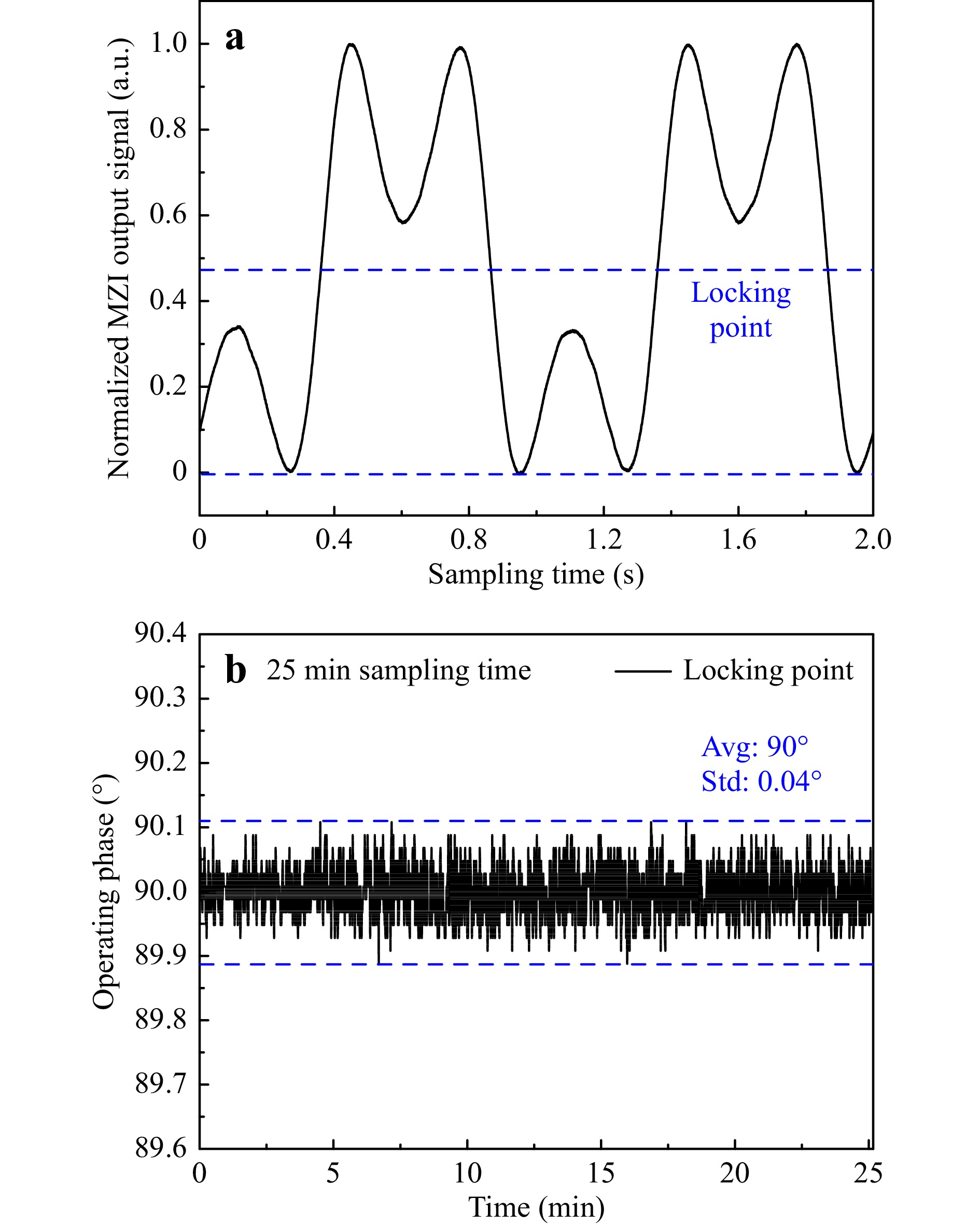
Fig. 3 a A certain MZI output using PZT scanning method (PZT: sinewave at 1 Hz and peak to peak voltage of 2 V). b MZI stability measurement at the quadrature locking point.
Fig. 4a shows a typical MZI output waveform with the control beam modulated sinusoidally in intensity at 3 kHz. The control power delivered to the AR-HCF is 650 mW and the gas pressure is 3.3 bar. It should be noted that the control power is measured after the HCF output, which is approximately equal to the power inside the HCF due to the low transmission loss at ~1530 nm (<0.1 dB with 19 cm-long HCF). The phase modulation amplitude is read out by using a method described in Ref. 27, where a time-domain method is demonstrated in which the dynamic phase modulation index applied to an interferometer is directly measured from the MZI waveform. For the waveform shown in Fig. 4a, T represents one control modulation period, and the phase modulation is calculated based on the waveform within half of a modulation period (with highlighted curve in Fig. 4a, from V1 to V2), to be 2.14π rad. With this method, the frequency response of the MIR phase modulator is determined and shown in Fig. 4b. The phase modulation amplitude reduces with increasing modulation frequency. With reference to the value at 3 kHz, the phase modulation reduces to half of the value at ~10 kHz.
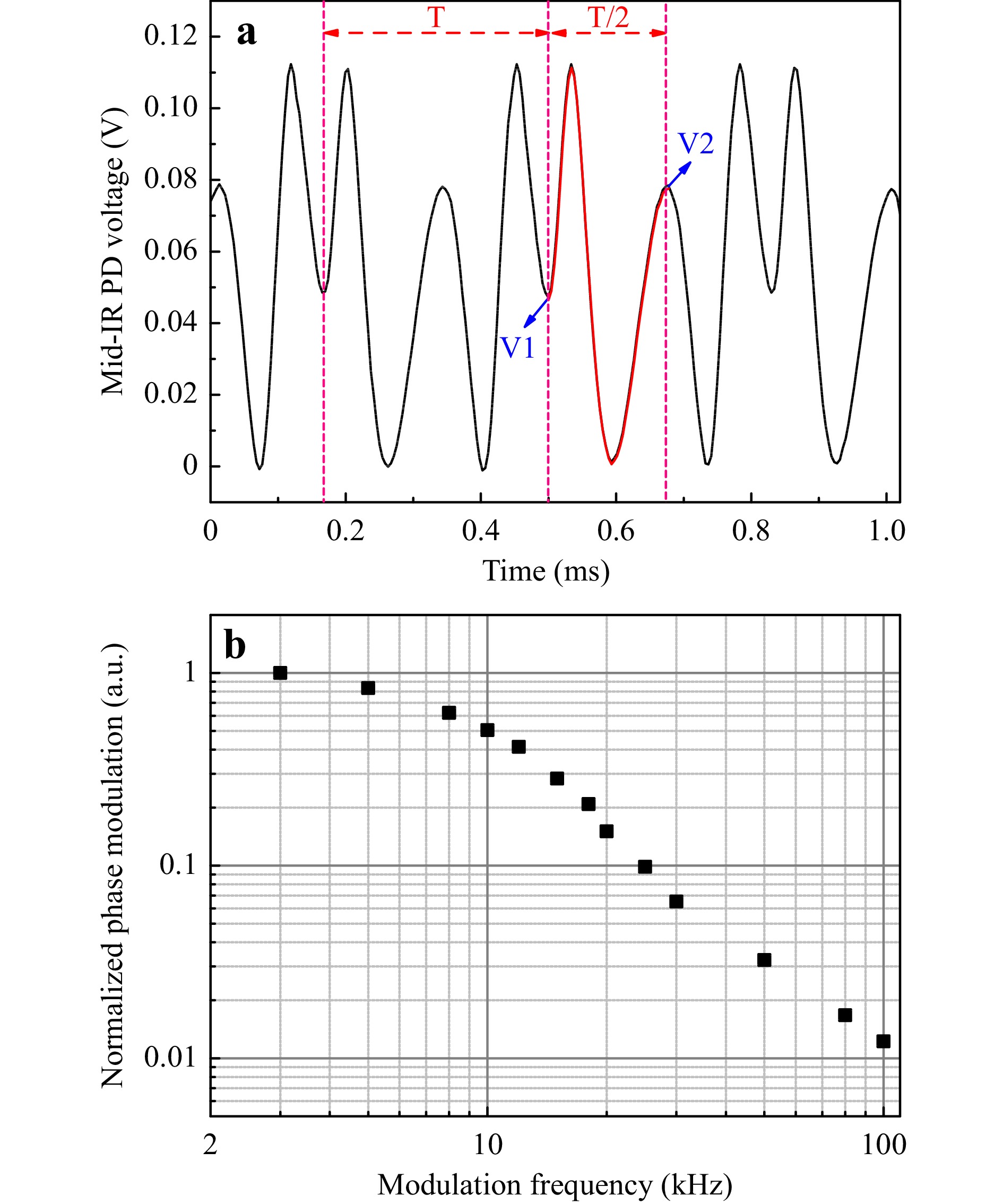
Fig. 4 a An example of MZI output waveform with modulation frequency of 3 kHz. b Normalized frequency response of the MIR phase modulator.
Fig. 5a shows the amplitude of the phase modulation as a function of power level of the control beam at the modulation frequency of 3 kHz for the gas pressure of 2 bar. The phase modulation increases nonlinearly with control power level and reaches π rad at the control power of ~280 mW. The minimum HCF length for π rad phase modulation of the MIR beam is estimated to be 7.7 cm. This is because nearly 99% of the control light is absorbed by the pure C2H2 at this length, and longer fibers may have little effect on the photo-thermal phase modulation. Furthermore, as control power increases, the gas temperature in the HCF also increases. We believe that the temperature change at high control power is responsible for the nonlinear response23,28. Simulated distribution of temperature inside the HCF using COMSOL Multiphysics indicates that the temperature may change up to 100 K in the core center of the HCF. Here we assume that the temperature changes from 300 to 400 K, the temperature-dependent absorption coefficient is reduced from 0.6 to 0.4 cm−1 (33%), the gas density is reduced from 1.04 to 0.78 kg/m3 (25%), the thermo-optical coefficient is reduced from −1.82 × 10−6 to −1.365 × 10−6 K−1 (25%), the heat capacity is increased from 1699 to 1938 J/(kg·K) (14%), and the heat conductivity is increased from 0.0214 to 0.0333 W/(m·K) (55%). It should point out that all these factors have negative gain on the phase modulation, which jointly responsible for the nonlinear behavior.

Fig. 5 Dependence of phase modulation on a power level of the control beam and b gas pressure in the AR-HCF. Error bars show the standard deviation of five measurements.
Fig. 5b shows the amplitude of phase modulation at 3 kHz with the control power of 650 mW for different gas pressure inside the AR-HCF. The phase modulation increases approximately linearly with gas pressure. The gas molecular density increases with the pressure level, which leads to increased phase modulation. The phase modulation reaches 2.2 π rad for the gas pressure of 3.4 bar.
-
The MIR all-optical intensity modulation is demonstrated with the gas pressure of 2 bar. We first adjust the two irises to balance the power of the two interference arms as much as possible so that the interference minima are close to zero. Instead of operating at quadrature, here the MZI is stabilized at an interference minima by use of a first harmonic (1f)-locking method described in Ref. 29. The piezo-mounted mirror is dithered at 1 kHz and the first harmonic is detected using a lock-in amplifier, which is used as the error signal for the servo-loop with a bandwidth of 1 Hz.
To characterize the modulation/switching feature of the intensity modulator, the control beam is modulated via the AOM with square wave of tunable repetition rate. Fig. 6a shows the measured waveforms of the input control beam and output signal beam with a repetition frequency of 20 Hz and a duty cycle of 50%. The response time of the intensity modulator is estimated following the 10%-90% rule30. Time constants for the rising and falling edges are evaluated to be 1.8 ms and 1.2 ms, respectively, which are limited by the heat dissipation process in the gas-filled AR-HCF. The “on-off ” switching capability of the modulator is also evaluated. Without the control beam, the MZI IM output keeps near zero, corresponding to “off” state. With modulated control beam, the IM output changes periodically between zero and the maximum. Here we define the on-off ratio of the IM as the ratio of the maximum value to the minimum value of the IM output, as
$ 10\mathrm{l}\mathrm{g}({V}_{\max}/{V}_{\min}). $ Fig. 6a shows the measured IM output with a relatively low “off” value under the conditions of control beam power of 82 mW and modulation frequency of 20 Hz. An on-off ratio value of ~25 dB is achieved.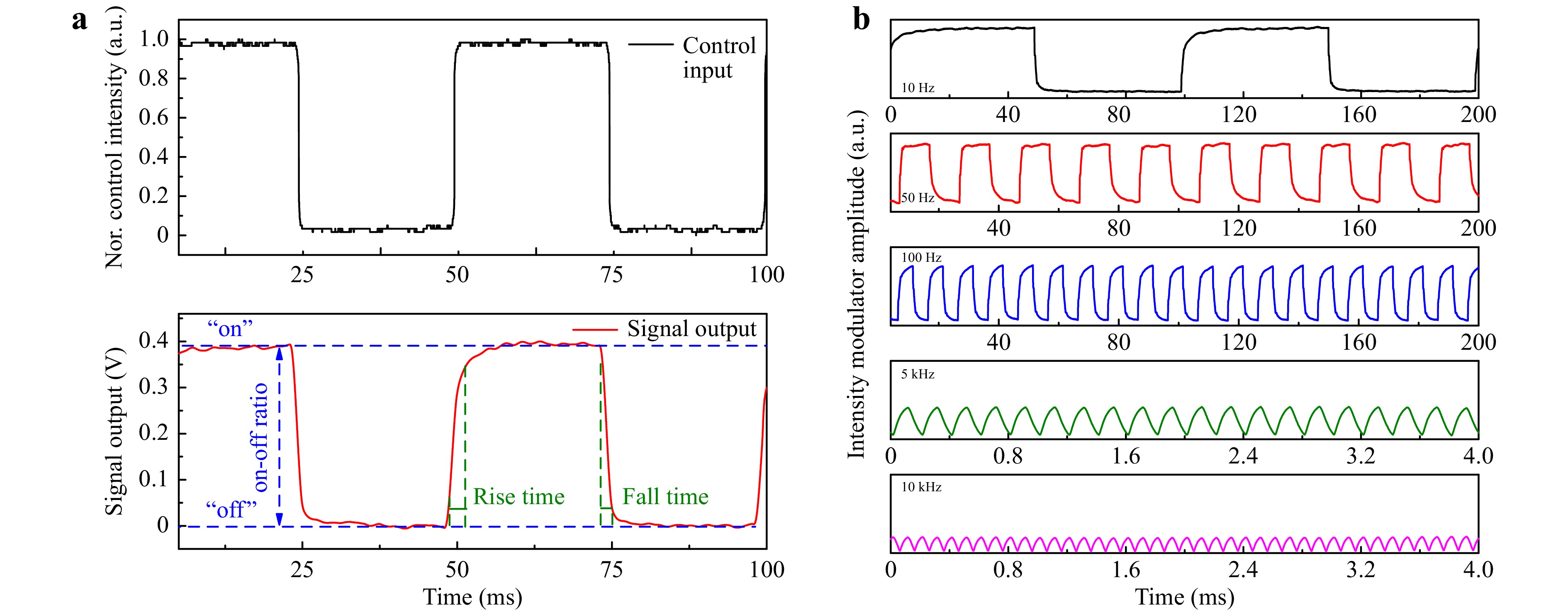
Fig. 6 a Waveforms of input control and output signal beam at 20 Hz. b Measured signal waveforms with repetition frequency from 10 Hz to 10 kHz.
To further investigate the frequency dependence of the intensity modulation, the repetition frequency is varied from 10 Hz to 10 kHz and some of the corresponding signal waveforms are shown in Fig. 6b. As the modulation frequency increases, the rise/fall times are basically unchanged, but the signal waveform gradually changes from a square wave to a sinusoidal wave. The amplitude is found reduced by nearly 80% at 10 kHz, which may be limited by the thermal dynamics in the gas-filled HCF.
-
The ultra-broadband low-loss transmission of the AR-HCF means that the fabricated modulators could also work well in the NIR band. We test this by using 1.55 μm fiber laser as the signal beam, which is launched into the system through the WDM, as indicated in the dotted line in Fig. 2. To achieve high coupling efficiency between NIR signal beam and the AR-HCF, the spot parameter of the focused beam is optimized to match the hollow-core diameter of the AR-HCF. The MIR photodetector is replaced by an NIR photodetector.
Fig. 7a, b show, respectively, the phase modulation as functions of control light power and gas pressure. At the control frequency of 3 kHz and AR-HCF gas pressure of 3 bar, a maximum phase modulation of 3.4π rad is obtained at the control power of 650 mW. The phase modulation increases linearly with pressure in the range of 1-3.5 bar for the control light power of 82 mW.
Fig. 8a shows the intensity modulation waveform at the frequency of 100 Hz and control power of 82 mW. The rising time and falling time are 1.8 ms and 1.2 ms, the same as the MIR intensity modulator. The waveforms for increasing modulation frequency from 50 Hz to 10 kHz are shown in Fig. 8b, similar to those of the MIR intensity modulation.
-
In Table 1, we summarize parts of the performances of the current commercial and state-of-the-art MIR phase/intensity modulators13,14,31-33. Commercially available MIR phase modulator can operate modulation speed of up to 20 GHz, but it can only work at one fixed resonant frequency without the wideband tunable function31. In addition, the maximum amplitude of the phase modulation is less than π rad in the MIR band. Furthermore, the damage threshold of the commercial PM is about ~1 W/mm2, while the damage threshold of the gas-filled HCF PM can reach up to >106 W/mm2 level, nearly 6 orders of magnitude larger than the commercial one34. Therefore, the wide-band gas-filled HCF MIR modulator is promising for high-power application, which is challenging to achieve with solid state materials.
Ref. Materials Effect Phase modulation (PM) Modulation bandwidth On-off ratio
(IM)Wavelength band Insertion
loss31a Crystal Pockelsc < 1π Resonant frequencye NA 1-3 or 3.1-7.4 or
7.5-12 μmfNot stated 32b Ge-on-Si waveguide Electro-absorptionc 0.75π 60 MHz 13 dB 3.8 μm Not stated 33b Ge-on-Si waveguide free-carrier absorptiond NA 55 MHz 5.1 dB 2-3 μm Not stated 13b SoI waveguide thermo-opticc NA 21.3 kHz 17.8 dB 3.8 μm 11.8 dB 14b SiLN waveguide Pockelsc NA 23 kHz 8 dB 3.39 μm 3.3 dB This work C2H2 in HCF Photothermald 2.2π 10 kHz >25 dB 1-4 μmg 3 dB (PM)
6.9 dB (IM)a: the commercial modulator, b: state-of-the-art modulator, c: electrically driven modulator, d: all-optical modulator, e: The user can only select one fixed resonant frequency from 0.1 MHz to 20 GHz, f: The working spectral range is discontinuous, users can only purchase one or more devices in the discrete 1-3 or 3.1-7.4 or 7.5-12 μm bands, g: The transmission losses (less than 0.5 dB/m) are measured at several wavelengths, and the actual transmission range is broadband, which can reach at least 1-4 μm. Ge-on-Si: germanium-on-silicon, SoI: Silicon-on-insulator, SiLN: silicon-on-lithium-niobate, NA: Not applicable. Table 1. The performance of current commercial and state-of-the-art MIR phase/intensity modulators.
State-of-the-art modulators based on different mechanisms have been developed13,14,32,33, but most MIR modulators are electrically driven by external electronics applied directly on the modulation device. Comparing with electrically driven modulators, the gas-filled HCF modulator enable all-optical modulation, within which the signal beam is modulated by the control beam in photonic domain without applying any external electronic or other physics effects. Besides, in this work, a cost-efficient laser in the telecom band is used as the NIR control beam to achieve phase and intensity modulation over an ultra-broad band from NIR to MIR. Due to its own material properties and heat conduction process, the bandwidth and modulation frequency of the gas-filled HCF MIR modulator is currently limited to kHz-level, relatively slower than that of crystal or waveguide-based modulators. Nevertheless, the proposed modulator has almost the widest operating spectral range from NIR to MIR and relatively high intensity modulation on-off ratio. With respect to the effects of nonlinear absorption and refraction, the former is relatively weak in gas-filled HCF even with light intensity of up to hundreds of MW/cm2 level34. For the latter effect, the nonlinear rafractive index (n2) of gas is in the ~10−19 cm2/W level, which is nearly 7-15 orders lower than that of solid state materials (~10−4 to 10−12 cm2/W level)35,36. Therefore, these two effects in gas-filled HCFs are indeed much weaker than in solid state materials.
It is worth pointing out that the application of the kHz-level MIR modulator may be limited in the field of communication field, but they may have other potential applications where fast modulation is not required6. Actually, this issue can be alleviated by using an HCF with a smaller core diameter so that heat conduct to the environment via the fiber cladding is faster to achieve modulation bandwidth of MHz or higher. Additionally, by using an HCF filled gas with a larger thermo-optic coefficient, and at a higher gas pressure, the control power level required to produce π rad of phase modulation could be reduced. The control power required for π rad phase change in the MIR is larger than that in the NIR, which is expected because the phase change, for the same RI modulation, is inversely proportional to the signal wavelength λ.
In summary, we have demonstrated all-optical phase and intensity modulators from NIR to MIR based on photo-thermal effect in a C2H2-filled AR-HCF. The phase of the signal beam is directly modulated by a NIR control beam, leading to signal phase modulation up to 2.2π rad in the MIR and 3.4π rad in the NIR range. By using a power-matched MZI together with this phase modulator, we have also demonstrated an intensity modulator with on-off ratio of 25 dB. This work brings HCF to the field of MIR modulator devices. The gas-filled HCF may be used as an effective platform to expand the scope of MIR modulators to achieve new photonic functionalities.
-
The AR-HCF gas cell used in the experiment is made of aluminum. The MIR/NIR beam is coupled into the AR-HCF via optical collimator and convex lens as demonstrated in Fig. 2. The AR-HCF is inserted into a ceramic ferrule and the ferrule is embedded in the homemade gas cell. The two ends of the AR-HCF are sealed with CaF2 windows for light coupling. The AR-HCF is also aligned to the input control and signal beam, and the relative positions are adjusted by use of a 3-axis translation stage under the gas cell to achieve a reasonable coupling efficiency. For gas filling purpose, gas inlet and outlet are equipped on both sides of the cell, and a gap of ~1 mm is kept between the CaF2 windows and HCF, which allows pure C2H2 filling into the hollow-core area.
-
This work was supported by the National Key Research and Development Program of China (2019YFB2203904); National Natural Science Foundation of China (61827820, 62005233); the Shenzhen STIC Funding (RCBS20200714114819032); the Local Innovative and Research Teams Project of Guangdong Pear River Talents Program (2019BT02X105).
Mid-infrared all-optical modulators based on an acetylene-filled hollow-core fiber
- Light: Advanced Manufacturing 3, Article number: (2022)
- Received: 03 July 2022
- Revised: 31 October 2022
- Accepted: 02 November 2022 Published online: 17 November 2022
doi: https://doi.org/10.37188/lam.2022.050
Abstract: We report all-optical mid-infrared phase and intensity modulators based on the photo-thermal effect in an acetylene-filled anti-resonant hollow-core fiber. Optical absorption of the control beam promotes the gas molecules to a higher energy level, which induces localized heating through non-radiative relaxation and modulates the refractive index of the gas material and hence the accumulated phase of the signal beam propagating through the hollow-core fiber. By modulating the intensity of the control beam, the phase of the signal beam is modulated accordingly. By use of a 1.53 µm near-infrared control beam, all-optical phase modulation up to 2.2π rad is experimentally demonstrated at the signal wavelength of 3.35 µm. With the phase modulator placed in one arm of a Mach-Zehnder interferometer, intensity modulation with on-off ratio of 25 dB is achieved. The gas-filled hollow-core-fiber modulators could operate over an ultra-broad wavelength band from near- to mid-infrared and have promising application in mid-infrared photonic systems.
Research Summary
Mid-infrared all-optical modulators based on an acetylene-filled hollow-core fiber
Mid-infrared optical modulators are key elements of photonic circuits that enable signal switching, data encoding, phase-sensitive detection, and spectroscopic sensing. Hollow-core-fiber is an excellent platform for mid-infrared modulator with long interaction distance, low transmission loss and broad wavelength band. Wei Jin from China’s Hong Kong Polytechnic University and colleagues now report development of mid-infrared all-optical phase and intensity modulators based on the photo-thermal effect in an acetylene-filled anti-resonant hollow-core fiber. The team demonstrated phase and intensity modulator performances both in the near-and mid-infrared band and large phase modulation amplitude and high on-off intensity modulation ratio are achieved. Their work brings hollow-core fiber to the field of mid-infrared modulator devices, and is expected to expand the scope of mid-infrared modulators to achieve new photonic functionalities.
Rights and permissions
Open Access This article is licensed under a Creative Commons Attribution 4.0 International License, which permits use, sharing, adaptation, distribution and reproduction in any medium or format, as long as you give appropriate credit to the original author(s) and the source, provide a link to the Creative Commons license, and indicate if changes were made. The images or other third party material in this article are included in the article′s Creative Commons license, unless indicated otherwise in a credit line to the material. If material is not included in the article′s Creative Commons license and your intended use is not permitted by statutory regulation or exceeds the permitted use, you will need to obtain permission directly from the copyright holder. To view a copy of this license, visit http://creativecommons.org/licenses/by/4.0/.


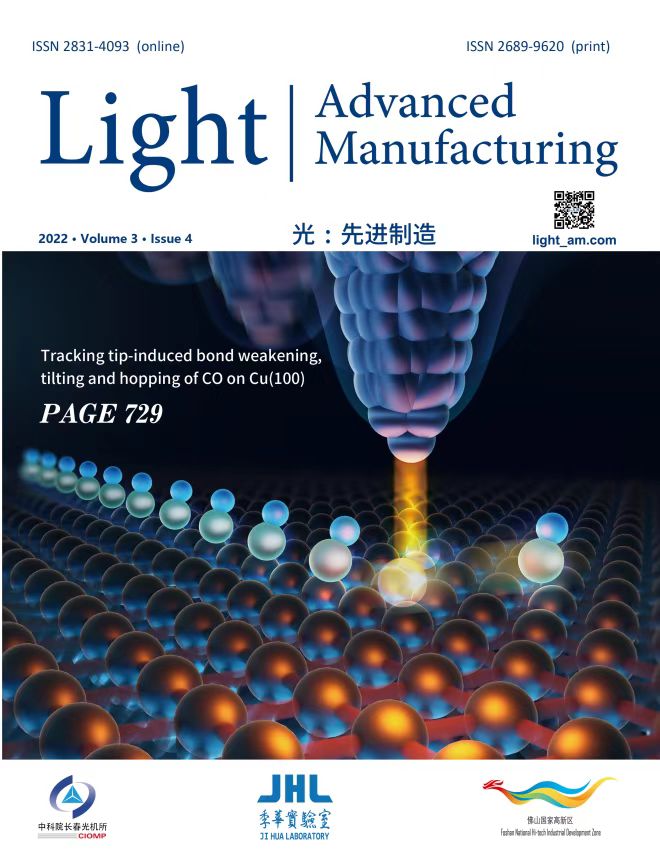






 DownLoad:
DownLoad: